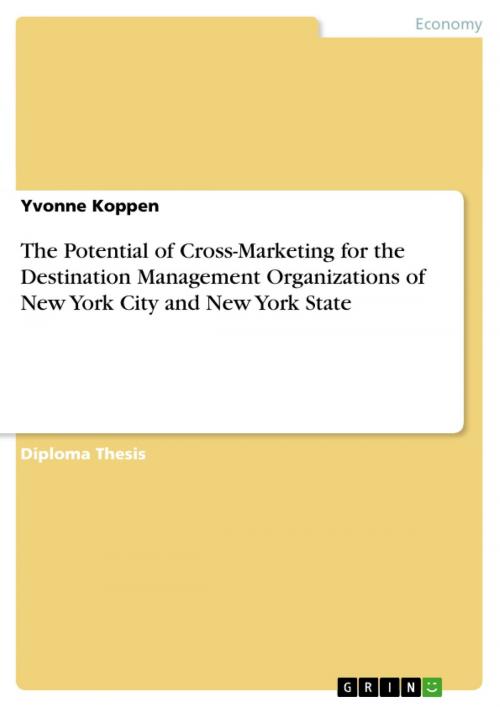The Potential of Cross-Marketing for the Destination Management Organizations of New York City and New York State
Business & Finance, Industries & Professions, Hospitality, Tourism & Travel| Author: | Yvonne Koppen | ISBN: | 9783640467334 |
| Publisher: | GRIN Publishing | Publication: | November 9, 2009 |
| Imprint: | GRIN Publishing | Language: | English |
| Author: | Yvonne Koppen |
| ISBN: | 9783640467334 |
| Publisher: | GRIN Publishing |
| Publication: | November 9, 2009 |
| Imprint: | GRIN Publishing |
| Language: | English |
Diploma Thesis from the year 2009 in the subject Tourism, grade: 1,5, Euro-Business-College Bonn, language: English, abstract: 1New York - more than a city that never sleeps 1.1Problem situation In spite of the financial crisis, the United States of America is one of the most popular countries to visit for Germans, in the past and present. Several reasons account for this positive effect. First of all, the consistently weak U.S. Dollar compared to the strong Euro is a tourist magnet. The new political image in the person of President Obama should not be underestimated, either. Another reason is the dropping of airline prices to popular destinations within the United States (Fischer, 2009). Clearly in the lead is the destination New York City (NYC), as number one visited destination in the country. This is especially true with the explosion of the phenomenon known as 'shopping tourism', which is captured in the growing amount of visitors' spending. After having surpassed Orlando and Las Vegas in 2007, in terms of visitors' spending, New York City set a new record in 2008 by recording $30 billion dollars spent only by visitors (Heywood & Spell, 2008a). The importance of this industry is emphasized by Michael R. Bloomberg, Mayor of New York City: 'Despite the economic challenges all cities are facing, tourism remains a bright spot for New York City, with 47 million visitors spending $30 billion here in 2008, the highest totals we've ever achieved. (...) The number of overseas travelers coming to New York City continues to rise, and now roughly a third of all who come to the United States (U.S.) come to New York.' (Heywood & Spell, 2008a). Not all destinations can register overseas visitor numbers in the dimensions that New York City can. Reflecting the media image and the author's own perception, in Germany, New York is perceived as 'the city that never sleeps'. New York State (NYS), however, might not notice much of the tourist boom taking place in its largest city. It might be difficult to say at this point that New York State is not recognized as a travel destination in Germany, but it is a fact that the State's overseas visitor numbers are far from the statistics for New York City. Thus the question arises, whether the State can jump onto the train the City is driving. 1.2Purpose and conception of the thesis This thesis is concerned with the tourism destinations of New York City and New York State for the German market. The objective is to expose possible potential to achieve positive synergy effects for both destinations by the means of Cross-Marketing.
Diploma Thesis from the year 2009 in the subject Tourism, grade: 1,5, Euro-Business-College Bonn, language: English, abstract: 1New York - more than a city that never sleeps 1.1Problem situation In spite of the financial crisis, the United States of America is one of the most popular countries to visit for Germans, in the past and present. Several reasons account for this positive effect. First of all, the consistently weak U.S. Dollar compared to the strong Euro is a tourist magnet. The new political image in the person of President Obama should not be underestimated, either. Another reason is the dropping of airline prices to popular destinations within the United States (Fischer, 2009). Clearly in the lead is the destination New York City (NYC), as number one visited destination in the country. This is especially true with the explosion of the phenomenon known as 'shopping tourism', which is captured in the growing amount of visitors' spending. After having surpassed Orlando and Las Vegas in 2007, in terms of visitors' spending, New York City set a new record in 2008 by recording $30 billion dollars spent only by visitors (Heywood & Spell, 2008a). The importance of this industry is emphasized by Michael R. Bloomberg, Mayor of New York City: 'Despite the economic challenges all cities are facing, tourism remains a bright spot for New York City, with 47 million visitors spending $30 billion here in 2008, the highest totals we've ever achieved. (...) The number of overseas travelers coming to New York City continues to rise, and now roughly a third of all who come to the United States (U.S.) come to New York.' (Heywood & Spell, 2008a). Not all destinations can register overseas visitor numbers in the dimensions that New York City can. Reflecting the media image and the author's own perception, in Germany, New York is perceived as 'the city that never sleeps'. New York State (NYS), however, might not notice much of the tourist boom taking place in its largest city. It might be difficult to say at this point that New York State is not recognized as a travel destination in Germany, but it is a fact that the State's overseas visitor numbers are far from the statistics for New York City. Thus the question arises, whether the State can jump onto the train the City is driving. 1.2Purpose and conception of the thesis This thesis is concerned with the tourism destinations of New York City and New York State for the German market. The objective is to expose possible potential to achieve positive synergy effects for both destinations by the means of Cross-Marketing.















